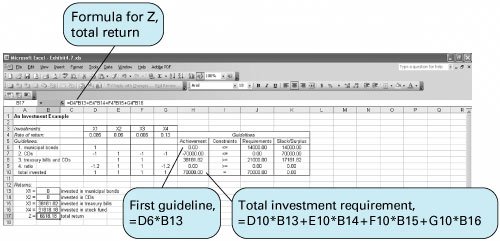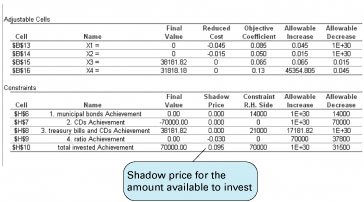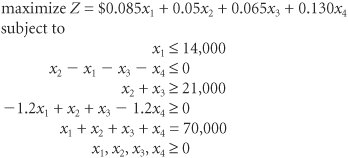An Investment Example
| Kathleen Allen, an individual investor, has $70,000 to divide among several investments. The alternative investments are municipal bonds with an 8.5% annual return, certificates of deposit with a 5% return, treasury bills with a 6.5% return, and a growth stock fund with a 13% annual return. The investments are all evaluated after 1 year. However, each investment alternative has a different perceived risk to the investor; thus, it is advisable to diversify. Kathleen wants to know how much to invest in each alternative in order to maximize the return. The following guidelines have been established for diversifying the investments and lessening the risk perceived by the investor:
Kathleen wants to invest the entire $70,000. Decision VariablesFour decision variables represent the monetary amount invested in each investment alternative: x 1 = amount ($) invested in municipal bonds x 2 = amount ($) invested in certificates of deposit x 3 = amount ($) invested in treasury bills x 4 = amount ($) invested in growth stock fund The Objective FunctionThe objective of the investor is to maximize the total return from the investment in the four alternatives. The total return is the sum of the individual returns from each alternative. Thus, the objective function is expressed as maximize Z = $0.085 x 1 + 0.05 x 2 + 0.065 x 3 + 0.130 x 4 where
Model ConstraintsIn this problem the constraints are the guidelines established for diversifying the total investment. Each guideline is transformed into a mathematical constraint separately. The first guideline states that no more than 20% of the total investment should be in municipal bonds. The total investment is $70,000; 20% of $70,000 is $14,000. Thus, this constraint is x 1 The second guideline indicates that the amount invested in certificates of deposit should not exceed the amount invested in the other three alternatives. Because the investment in certificates of deposit is x 2 and the amount invested in the other alternatives is x 1 + x 3 + x 4 , the constraint is x 2 This constraint is not in what we referred to in Chapter 3 as standard form for a computer solution. In standard form, all the variables would be on the left-hand side of the inequality ( x 2 x 1 x 3 x 4 Standard form requires all variables to be to the left of the inequality and numeric values to the right . The third guideline specifies that at least 30% of the investment should be in treasury bills and certificates of deposit. Because 30% of $70,000 is $21,000 and the amount invested in certificates of deposit and treasury bills is represented by x 2 + x 3 , the constraint is x 2 + x 3 The fourth guideline states that the ratio of the amount invested in certificates of deposit and treasury bills to the amount invested in municipal bonds and the growth stock fund should be at least 1.2 to 1: [( x 2 + x 3 )/( x 1 + x 4 )] This constraint is not in standard linear programming form because of the fractional relationship of the decision variables, ( x 2 + x 3 )/( x 1 + x 4 ). It is converted as follows : Standard form requires that fractional relationships between variables be eliminated . Finally, the investor wants to invest the entire $70,000 in the four alternatives. Thus, the sum of all the investments in the four alternatives must equal $70,000: x 1 + x 2 + x 3 + x 4 = $70,000 Model SummaryThe complete linear programming model for this problem can be summarized as Computer Solution with ExcelThe Excel spreadsheet solution for the investment example is shown in Exhibit 4.7, and its Solver window is shown in Exhibit 4.8. The spreadsheet is set up very similarly to the spreadsheet for our product mix example in Exhibit 4.1. The decision variables are located in cells B13:B16 . The total return ( Z ) is computed in cell B17, and the formula for Z is shown on the formula bar at the top of the spreadsheet. The constraint formulas for the investment guidelines are embedded in cells H6 through H10. For example, the first guideline formula, in cell H6, is = D6*B13 , and the second guideline formula, in cell H7, is = D7*B13+E7*B14+F7*B15+G7*B16 . (Note that it would probably have been easier just to type the guideline formulas directly into cells H6 through H10 rather than create the array of constraint coefficients in D6:G10 ; however, for demonstration purposes, we wanted to show all the parameter values.) Exhibit 4.7. Exhibit 4.8. As mentioned earlier, it is not necessary to convert the original model constraints into standard form to solve this model using Excel. For example, the constraint for certificates of deposit, x 2 Solution AnalysisThe solution is x 3 = $38,181.82 invested in treasury bonds x 4 = $31,818.18 invested in a growth stock fund Z = $6,818.18 The sensitivity report for our Excel spreadsheet solution to this problem is shown in Exhibit 4.9. Exhibit 4.9. Notice that the dual (shadow price) value for constraint 5 (i.e., the sum of the investments must equal $70,000) is 0.095. This indicates that for each additional $1 Kathleen Allen invests (above $70,000), according to the existing investment guidelines she has established, she could expect a return of 9.5%. The sensitivity ranges show that there is no upper bound on the amount she could invest and still receive this return. An interesting variation of the problem is to not specify that the entire amount available (in this case, $70,000) must be invested. This changes the constraints for the first and third guidelines and the constraint that requires that the entire $70,000 be invested. Recall that the first guideline is "no more than 20% of the total investment should be in municipal bonds." The total investment is no longer exactly $70,000, but the sum of all four investments, x 1 + x 2 + x 3 + x 4 . The constraint showing that the amount invested in municipal bonds, x 1 , as a percentage (or ratio) of this total cannot exceed 20% is written as Rewriting this constraint in a form more consistent with a linear programming solution (to eliminate the fractional relationship between variables) results in x 1 and 0.8 x 1 0.2 x 2 0.2 x 3 0.2 x 4
The constraint for the third guideline, which stipulates that at least 30% of the total investment ( x 1 + x 2 + x 3 + x 4 ) should be in treasury bills and CDs ( x 2 + x 3 ), is formulated similarly as and -0.3 x 1 + 0.7 x 2 + 0.7 x 3 0.3 x 4 Because the entire $70,000 does not have to be invested, the last constraint becomes x 1 + x 2 + x 3 + x 4 The complete linear programming model is summarized as The solution to this altered model is exactly the same as the solution to our original model, wherein the entire $70,000 must be invested. This is logical because only positive returns are achieved from investing, and thus the investor would leave no money not invested. However, if losses could be realized from some investments, then it might be a good idea to construct the model so that the entire amount would not have to be invested. |
EAN: 2147483647
Pages: 358

 $14,000
$14,000  $21,000
$21,000 

